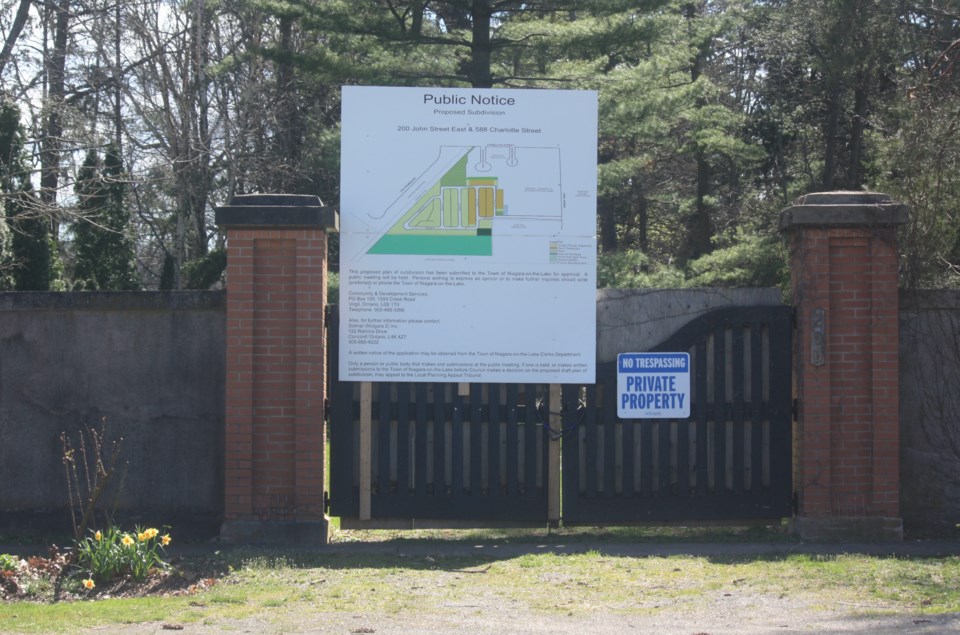The Rand Estate property was given much of its character through work by notable Canadian landscape architects Howard and Lorrie Dunnington-Grubb in the early 20th century.
Referred to as the Dunnington-Grubb landscape, some of its elements were part of the discussion in Monday’s proceedings at an Ontario Land Tribunal hearing. Monday was the first day in week three of the hearing prompted by appeals from Solmar Development and their plans to build almost 200 homes on the historic property in Niagara-on-the-Lake's Old Town.
During testimony, Tim McCormick, a landscape architect and Solmar witness who has been involved with plans for the proposal for a number of years, told the tribunal the panhandle, where the developer is proposing an access to its subdivision, a nearby mound, a walkway and whistlestop are not part of the historic landscape. “There is no evidence to prove they are designed by Dunnington-Grubb,” he said.
A spot known as the “sunken garden” at 176 John St., he said, is part of the work by the famous landscapers. “There’s no debate” about it being part of the Dunnington-Grubb landscape, said McCormick, adding it’s “definitely clear that it’s part of it.”
There are 23 trees near the panhandle the developer plans to remove, but “there are trees being maintained in that area,” said McCormick. “That’s important to note.” And new trees can be planted, he added. “There will be room to plant new trees and build this area with new species again.”
McCormick said that any access to the subdivision will have heritage impacts in some way, but that the one pitched for the panhandle is the “only viable, legal” proposal. One to the west at 176 John St. Is his “preferred alternative,” he said, noting the importance of a tree management plan.
He also said that some heritage landscape features could be preserved through a condo agreement, protected with “the end goal that the heritage is maintained.”
With party status in the hearing are lawyers representing the Town of NIagara-on-the-Lake, Save Our Rand Estate (SORE), Solmar, and Blair and Brenda McArthur, who live at 210 John St.
SORE lawyer Catherine Lyons cross-examined McCormick Monday and raised a question about the site’s bath pavilion and a hedge leading up to it, which McCormick opined was not the work of Dunnington-Grubb because it was built before a pool garden. She also asked about a statement in his evidence that the town did not have information it could be confident about when it comes to what can be attributed to the Dunnington-Grubb work and what has survived. Asked by Lyons if he has evidence to support that, he replied he did not.
SORE is pitching a possible emergency access at the “pinchpoint” in the area of Weatherstone Court near Charlotte Street, which fire trucks would need to navigate a “challenging angle” to get through due to roots of a 250-year-old oak tree. When Lyons asked McCormick asked if he believes this needs to be considered, he said it would be “absolutely reasonable.”
Town lawyer Nancy Smith went back to features McCormick said were not part of the Dunnington-Grubb landscape, and pointed out that the “town says they are.” She then asked McCormick if he believes they are still part of the “cultural heritage landscape” of the property, and he agreed they are.
The hearing resumes Tuesday with more testimony and cross-examination of Solmar witnesses, such as agrologist Sean Colville, who began delivering evidence late in Monday’s deliberations.
It is also possible the hearing, initially planned to run until May 17, could conclude as late as mid-August. The panel is suggesting five additional days, and has recommended five different weeks in which those extra days could be held, the latest being the week of Aug. 12 to 16.
The schedule is expected to be sorted out this week.
